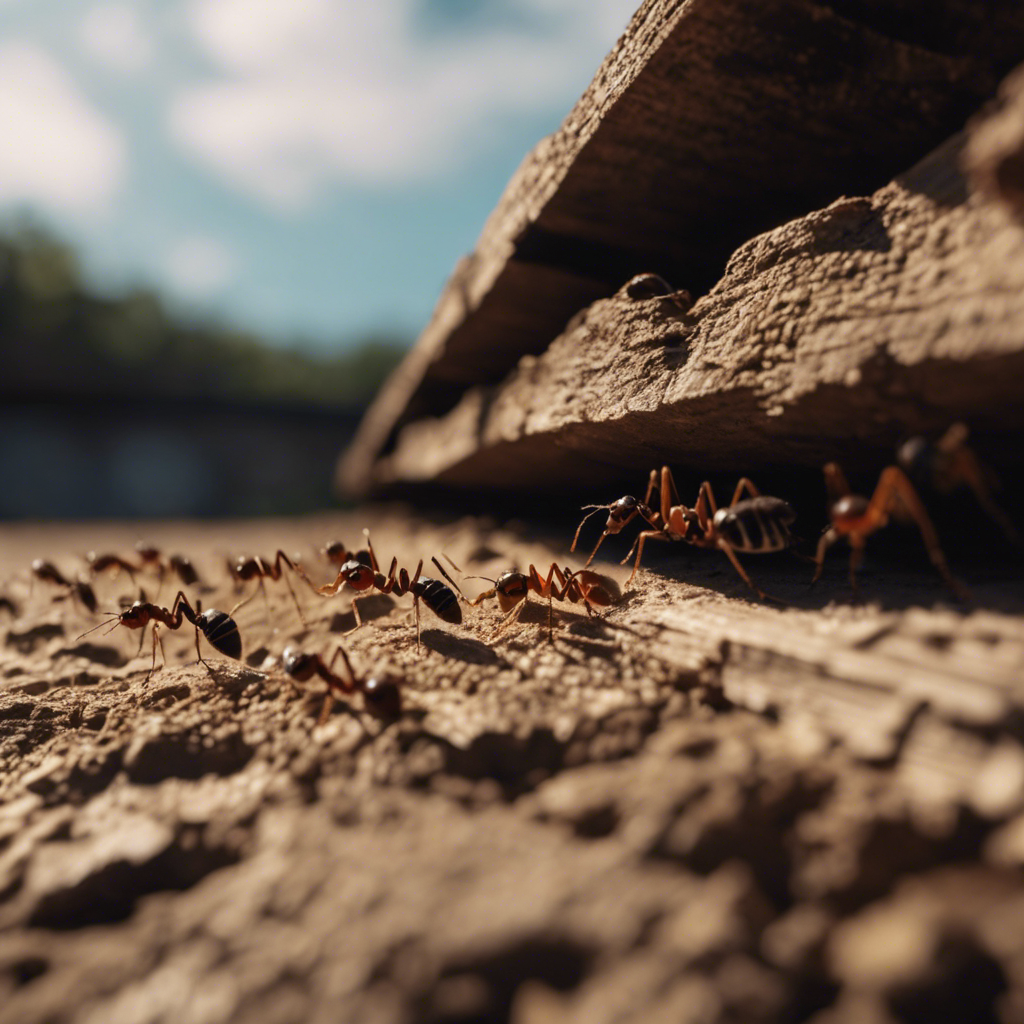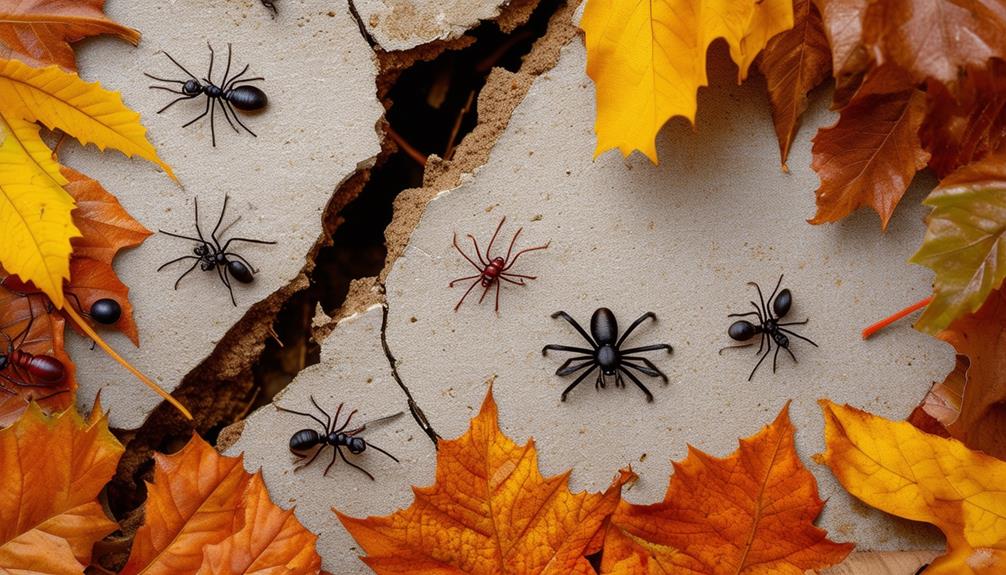Is your Oklahoma home experiencing some unwelcome visitors? You may have noticed a few signs that could indicate ants are causing damage, but it’s important to be aware of the subtle hints that often go unnoticed.
From the presence of frass to the sight of winged ants, these indicators can point to a potential problem. But that’s just the beginning. There are more signs to look for, and taking action sooner rather than later is crucial.
So, what are these signs? And what steps can you take to protect your home? Stay tuned, because we’re about to unveil the secrets that will help you uncover if ants are wreaking havoc in your Oklahoma home.
Key Takeaways
- Frass and piles of material resembling sawdust are signs of wood damage caused by carpenter ants.
- Winged ants, known as alates, can indicate the presence of a carpenter ant infestation.
- Chewing behavior by ants can lead to visible damage to wood structures, such as holes in window or door frames.
- Regular inspection, prevention measures, and prompt professional treatment are necessary to prevent further damage to the home.
Frass and Wood Damage
If you’re concerned about potential wood damage in your Oklahoma home, one telltale sign to look out for is the presence of frass, the waste produced by carpenter ants. Frass can be found on wood structures, the ground, and floors, indicating a carpenter ant infestation.
It can also be deposited inside wall, floor, and ceiling voids, suggesting potential wood damage. Piles of material resembling sawdust are a warning sign, as they indicate frass presence and potential wood damage.
Carpenter ants can cause visible damage to wood, including holes in window or door frames and deck support. Their tunnels are smooth to the touch, unlike the gritty tunnels of subterranean termites, further indicating wood damage.
Winged Ants and Wings
When examining signs of ant damage in your Oklahoma home, it’s important to observe the presence of winged ants and their shed wings as a key indicator of a carpenter ant infestation.
Here are some facts to consider:
- Winged female and male reproductives called alates are produced by mature carpenter ant nests.
- The presence of large winged ants inside or outside your home is a sign of a carpenter ant infestation.
- Winged ants swarm together for less than thirty minutes.
- Carpenter ant swarmers can appear and disappear quickly.
Shed wings can be found on window sills, floors, exterior door thresholds, patios, and in spider webs. These shed wings are a result of the mating flights that occur in spring and summer when young queens and males leave their nests to mate and establish new colonies.
Chewing by Ants
Carpenter ants cause damage to wood structures through their chewing behavior. These pests can be serious, as their chewing can lead to structural damage in your home. Carpenter ants establish their nesting sites in damp or decaying wood, and once they find a suitable location, they begin to excavate tunnels by chewing through the wood. You may hear chewing sounds when you put your ear to a wood timber, indicating an active carpenter ant infestation.
This chewing can result in visible damage such as holes in window or door frames, as well as deck supports. The wood damage caused by carpenter ants includes smooth tunnels, which can be a clear sign of an infestation. Taking prompt action is necessary to prevent further damage caused by the chewing and to protect your home from these pests.
Worker Ant Activity
Worker ants play a crucial role in the daily activities of an ant colony. They are responsible for foraging for food, transporting it back to the nest, and conducting mating flights. However, while they can be a nuisance, worker ants rarely cause structural damage to homes. To determine if worker ants are damaging your Oklahoma home, there are several signs to look out for.
- Observing worker ants foraging for food in and around your home.
- Noticing trails of worker ants traveling to and from a food source.
- Witnessing worker ants carrying food back to their nest.
- Finding frequent sightings of worker ants, which could indicate a nearby nest in your home.
It is important to note that the nest of worker ants is likely outdoors, but they can still be active indoors, especially if there are food scraps or a water source readily available. While worker ants are considered serious pests, their main focus is on conducting mating flights and gathering food for the colony. Promptly addressing worker ant activity is essential to prevent the colony population from growing and producing young queens.
Prevention and Treatment Tips
To effectively prevent and treat ant infestations in your Oklahoma home, it is essential to follow these detailed, informative, and scientific prevention and treatment tips:
| Prevention Tips | Treatment Tips |
|---|---|
| Regularly inspect and repair any leaks in and around your home to prevent moisture buildup that attracts carpenter ants. | Seek professional help at the first sign of carpenter ants to prevent extensive damage and eliminate the infestation effectively. |
| Keep gutters clean to ensure proper water drainage and prevent wood rot, which can attract carpenter ants. | Identify the nesting site of the carpenter ants and eliminate it, either by removing the decaying wood or using insecticides. |
| Remove any rotting wood from your property, as it is a prime nesting and feeding site for carpenter ants. | Seal cracks and openings around the exterior of your home to block potential entry points for carpenter ants. |
| Maintain a clean and tidy home, ensuring that there are no food scraps or honeydew left accessible to ants. | Implement preventive measures such as applying insecticides around the perimeter of your home to deter ants from entering. |
| Trim trees and shrubs that may be touching your home, as they can serve as bridges for ants to access your property. | Use baits and traps to target and eliminate ant colonies, focusing on areas with high ant activity. |
Frequently Asked Questions
How Do You Know if Your House Is Infested With Ants?
Do you ever wonder if your house is infested with ants? Well, there are some signs to look out for, such as frass, piles of sawdust-like material, shed wings, and even the sound of chewing.
When Should I Be Worried About Ants in My House?
When should you be worried about ants in your house? If you notice signs of an ant nest, like piles of frass or visible wood damage, it’s time to take action. Effective ant control methods and prevention tips can help keep ants out of your home.
Can Ants Cause Damage to Your House?
Yes, ants can cause damage to your home. Signs of damage include frass, piles of sawdust-like material, presence of winged ants, shed wings, and chewing sounds. Prompt action is necessary for ant control and prevention.
Are Ants in the House a Bad Omen?
Having ants in your house can be a nuisance, but they’re not necessarily a bad omen. Understanding their habits, implementing prevention tips, and using natural remedies can help keep them out.





